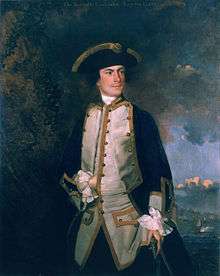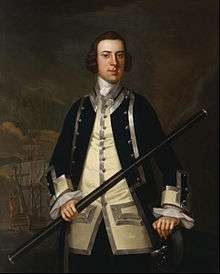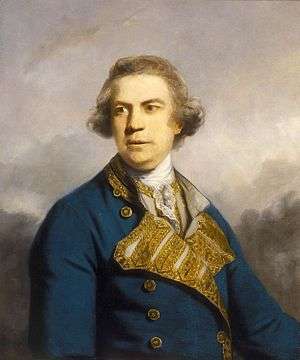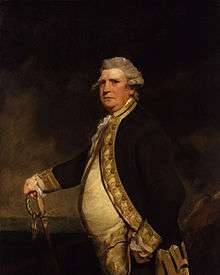Augustus Keppel, 1st Viscount Keppel
| The Viscount Keppel | |
|---|---|
 Keppel, 1749, Joshua Reynolds's first painting of him, produced on Menorca | |
| Born | 25 April 1725 |
| Died | 2 October 1786 (aged 61) |
| Allegiance |
|
| Service/branch |
|
| Years of service | 1735–1786 |
| Rank | Admiral of the White |
| Commands held | Jamaica Station |
| Battles/wars |
War of the Austrian Succession (Voyage round the world), Seven Years' War (Quiberon Bay), War of American Independence (Ushant) |
Admiral Augustus Keppel, 1st Viscount Keppel PC (25 April 1725 – 2 October 1786) was an officer of the Royal Navy during the Seven Years' War and the War of American Independence. During the final years of the latter conflict he served as First Lord of the Admiralty.
Early life
A member of a leading Whig aristocratic family (which had come to England with William of Orange in 1688), Augustus Keppel was the second son of Willem Anne van Keppel, 2nd Earl of Albemarle and Anne van Keppel, a daughter of the 1st Duke of Richmond (himself an illegitimate son of King Charles II). Augustus Keppel went to sea at the age of ten, and had already five years of service to his credit when he was appointed to Centurion and sent with Lord Anson round the world in 1740. He had a narrow escape from being killed at the capture of Paita (13 November 1741), and was named acting lieutenant in 1742. Also on this voyage, he made friends with John Campbell, and lost many of his teeth to the scurvy prevalent on the voyage. After their return from the circumnavigation, in 1744, he was promoted to be Commander and post-captain of the 14-gun sloop Wolf.[1] He was actively employed throughout the rest of the War of the Austrian Succession, until peace was signed in 1748. In 1747 he ran his ship Maidstone (50) ashore near Belleisle while chasing a French vessel, but was honourably acquitted by a court martial, and reappointed to another command.


Early in 1749, he was introduced by Lord Edgecombe to Sir Joshua Reynolds. When, on 11 May 1749, Commodore Keppel sailed from Plymouth to the Mediterranean, as Commodore commanding the Mediterranean Fleet,[2] (with his pennant in his old ship HMS Centurion intending to persuade the Dey of Algiers to restrain the piratical operations of his subjects) Reynolds travelled with him as far as Minorca and there painted the first of his 6 portraits of Keppel, left,[3] along with others of officers of the British garrison there.[4] After trying the effect of bullying without success, the Dey made a treaty, and Keppel returned to England in 1751.[2]
Seven Years' War
During the Seven Years' War he saw constant service. He served as Commander-in-Chief, North American Station from 1751 to 1755[5] He was on the coast of France in 1756 and was detached on an expedition to conquer Gorée, a French island off the west coast of Africa in 1758. His ship, Torbay (74), was the first to get into action in the Battle of Quiberon Bay in 1759.
In 1757 he had formed part of the court martial which had condemned Admiral Byng, but was active among those who endeavoured to secure a pardon for him; but neither he nor those who had acted with him could produce any serious reason why the sentence should not be carried out. In March 1761, Keppel transferred to HMS Valiant and was put in command of a squadron to reduce Belle Isle, which was successfully completed in June.
Havana expedition
When Spain joined France in 1762 he was sent as second in command with Sir George Pocock in the British expedition against Cuba which took Havana. His health suffered from the fever which carried off an immense proportion of the soldiers and sailors. The £25,000 of prize money which he received freed him from the unpleasant position of 'younger son of a family ruined by the extravagance of his father'.
Achievement of flag rank

Promoted to Rear Admiral in October 1762, he became Commander-in-Chief Jamaica Station late in the year.[6] He was a member of the Admiralty Board from July 1765 to November 1766 and was promoted Vice Admiral on 24 October 1770. When the Falkland Island dispute occurred in 1770 he was to have commanded the fleet to be sent against Spain, but a settlement was reached, and he had no occasion to hoist his flag.
American War of Independence
The most prominent period of his life belongs to the opening years of the American War of Independence. Keppel was a strong supporter of the Whig connection, led by the Marquess of Rockingham and the Duke of Richmond. The Whigs were then excluded from power by George III.
As a member of Parliament, in which he had a seat for Windsor from 1761 until 1780, and then for Surrey, Keppel was a Whig partisan, hostile to the King's Friends. The Whigs believed that the king's ministers, and in particular Lord Sandwich, then First Lord of the Admiralty, were capable of any villainy. When Keppel was appointed to command the Channel Fleet,[2] the main fleet prepared against France in 1778, he thought the First Lord would be glad for him to be defeated.
One of Keppel's subordinate admirals was Sir Hugh Palliser (1723–1796), a member of the Admiralty Board, a member of parliament, and in Keppel's opinion responsible with his colleagues for the bad state of the Royal Navy. The battle which Keppel fought with the French on 27 July 1778 (the First Battle of Ushant) ended badly. Reasons included Keppel's own management, but also the failure of Palliser to obey orders. Keppel became convinced that he had been deliberately betrayed.
Keppel–Palliser affair
Though Keppel praised Palliser in his public despatch, he attacked him in private. The Whig press, with Keppel's friends, began a campaign of calumny. The ministerial papers answered in the same style, and each side accused the other of deliberate treason. The result was a scandalous series of scenes in parliament and of courts martial. Keppel was first tried and acquitted 1779, and then Palliser was also tried and acquitted. Keppel was ordered to strike his flag in March 1779.
A column was built in the late 18th century to commemorate his acquittal, commissioned in 1778 by Charles Watson-Wentworth, 2nd Marquess of Rockingham and designed by John Carr.
Political career

Until the fall of Lord North's ministry he acted as an opposition member of parliament. He was MP for Chichester from 1755 to 1761, then for Windsor from 1761 to 1780 and finally for Surrey from 1780 to 1782.
When North's government fell in 1782 he became First Lord, was raised to the peerage as Viscount Keppel, of Elveden in the County of Suffolk,[7] and sworn of the Privy Council.[8] His career in office was not distinguished, and he broke with his old political associates by resigning as a protest against the Peace of Paris. He finally discredited himself by joining the Coalition ministry formed by North and Fox, and with its fall disappeared from public life.
Last years and legacy
Lord Keppel died unmarried on 2 October 1786. Burke, who regarded him with great affection, said that he had something high in his nature, and that it was a wild stock of pride on which the tenderest of all hearts had grafted the milder virtues. Keppel was briefly engaged in 1769 to Alice Lightfoot, great aunt of the future Bishop of Durham Joseph Barber Lightfoot however Keppel broke off the engagement for an undisclosed reason. The peerage died with him.
In popular culture
Keppel appears in Patrick O'Brian's The Golden Ocean as a midshipman aboard the Centurion. He is often the comic relief, winding up bald and toothless due to the various privations of the voyage.
See also
Named after Keppel:
Notes
- ↑ Winfield 2007, p. 300
- 1 2 3 Augustus Keppel at Oxford Dictionary of National Biography
- ↑ One of the 6, belonging originally to Edmund Burke, is now in the National Gallery, where there is also one by him of Keppel's mother.
- ↑ Reynolds then stayed on the island for the rest of 1749 before leaving for Rome, where he stayed 2 years.
- ↑ Augustus Keppel Archived 27 November 2010 at the Wayback Machine. Royal Navy Museum
- ↑ Cundall, p. xx
- ↑ The London Gazette: no. 12290. p. 1. 23 April 1782.
- ↑ The London Gazette: no. 12282. p. 1. 26 March 1782.
References
| Wikimedia Commons has media related to Augustus Keppel, 1st Viscount Keppel. |
-
 This article incorporates text from a publication now in the public domain: Chisholm, Hugh, ed. (1911). "article name needed". Encyclopædia Britannica (11th ed.). Cambridge University Press.
This article incorporates text from a publication now in the public domain: Chisholm, Hugh, ed. (1911). "article name needed". Encyclopædia Britannica (11th ed.). Cambridge University Press. - Cundall, Frank (1915). Historic Jamaica. West India Committee.
- Winfield, Rif (2007). British Warships of the Age of Sail 1714–1792: Design, Construction, Careers and Fates. Seaforth. ISBN 9781844157006.
| Parliament of Great Britain | ||
|---|---|---|
| Preceded by John Page Viscount Bury |
Member of Parliament for Chichester with John Page 1755–1761 |
Succeeded by John Page Lord George Henry Lennox |
| Preceded by Henry Fox John Fitzwilliam |
Member of Parliament for Windsor with John Fitzwilliam 1761-1768 Lord George Beauclerk 1768 Richard Tonson 1768-1772 John Hussey-Montagu 1772-1780 1761–1780 |
Succeeded by John Hussey-Montagu Peniston Portlock Powney |
| Preceded by Sir Joseph Mawbey James Scawen |
Member of Parliament for Surrey with Sir Joseph Mawbey 1780–1782 |
Succeeded by Sir Joseph Mawbey Viscount Althorp |
| Military offices | ||
| Preceded by Sir James Douglas |
Commander-in-Chief, Jamaica Station 1762–1764 |
Succeeded by William Burnaby |
| Political offices | ||
| Preceded by The Earl of Sandwich |
First Lord of the Admiralty 1782–1783 |
Succeeded by The Viscount Howe |
| Preceded by The Viscount Howe |
First Lord of the Admiralty 1783 |
Succeeded by The Viscount Howe |
| Peerage of Great Britain | ||
| New creation | Viscount Keppel 1782–1786 |
Extinct |